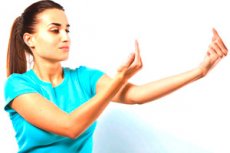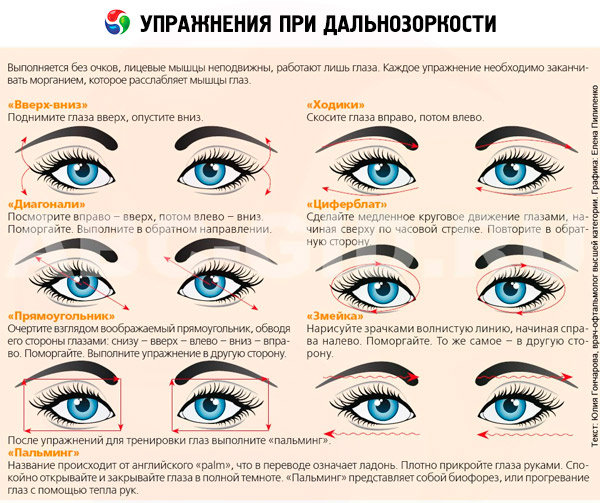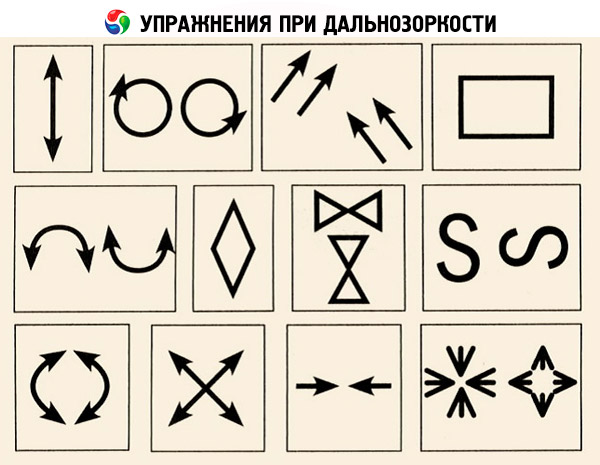Medical expert of the article
New publications
Eye exercises for hyperopia for children and adults by Zhdanov and Bates
Last reviewed: 04.07.2025

All iLive content is medically reviewed or fact checked to ensure as much factual accuracy as possible.
We have strict sourcing guidelines and only link to reputable media sites, academic research institutions and, whenever possible, medically peer reviewed studies. Note that the numbers in parentheses ([1], [2], etc.) are clickable links to these studies.
If you feel that any of our content is inaccurate, out-of-date, or otherwise questionable, please select it and press Ctrl + Enter.

Farsightedness or hyperopia is a pathological condition characterized by the lack of proper focusing of vision when examining objects at a close distance. With normal vision, the image of an object clearly falls on the retina of the eye, is converted into nerve impulses, recognized and analyzed by the brain. The presence of farsightedness changes refraction and shifts the focus. A clear image of an object appears as if behind the retina. Blurred contours of the object being examined fall on the thin nervous inner membrane of the eye. This pathology can be provoked by:
- individual shape of the eyeball with shortening along the longitudinal axis;
- age-related changes in lens accommodation;
- insufficient refractive power of the optical system of the visual organ.
The first alarming symptoms of the disease are:
- eye fatigue when looking at objects close up;
- high fatigue when reading;
- a feeling of fatigue when performing painstaking work that requires eye strain;
- the emergence of inflammatory pathologies.
To correct this pathology, doctors recommend the correct selection of appropriate contact lenses, glasses, drug therapy or surgery. It is possible to combine drug therapy and treatment of farsightedness with exercises that help strengthen, reduce tension and relax the oculomotor apparatus.
Exercises to improve and restore vision in farsightedness
Ophthalmologists successfully use training exercises for different structures of the eye in hyperopia. The combination of special exercises helps slow down the progression of the process that impairs visual acuity. Training exercises for the eyes are also recommended for the prevention of vision pathologies in childhood and adolescence, when the eyes are regularly subjected to excessive strain and experience constant fatigue.
Effective treatment of farsightedness with exercises helps restore visual acuity and prevents its deterioration. Thanks to the technique:
- Improves blood circulation in the cervical spine.
- Microhemodynamics in the tissues and structures of the eye are enhanced.
- The oculomotor apparatus is strengthened.
- The ability of the lens to accommodate normally is stimulated and maintained.
Exercises for farsightedness according to Zhdanov
Professor V. Zhdanov has developed a specific training system for various diseases and pathological conditions of the eyes. They are based on traditional ideas about the principle of the visual organ.
Treatment of farsightedness with exercises according to the method of Professor V. Zhdanov requires patience, time and strict adherence to the rules. Regular and precise performance of gymnastics for the oculomotor muscles will give a positive effect. Before performing the training: it is necessary to adhere to the following rules:
- Remove glasses or lenses (if any).
- Patients with retinal pathologies should perform exercises carefully and attentively.
- Repeat each exercise at least three times.
The effectiveness of the gymnastics complex for hyperopia is based on training the motor muscles of the eye through the occurrence of alternating tension and relaxation, bringing the fingers of the upper limbs closer and further away.
"First finger of the hand":
- The fingers of one hand are clenched into a fist.
- Raise your thumb up, showing "OK", stretch your hand forward, blink two or three times, look into the distance, then focus your gaze on the extended finger for 5 seconds. Gradually lower your hand down.
- Number of repetitions from 5 to 10 times.
"Finger Move":
- The fingers of the right hand are clenched into a fist.
- Move your index finger forward.
- Bring your hand to your face so that your index finger is at eye level.
- Look into the distance.
- Start moving your index finger quickly from side to side, trying not to focus on the finger.
- Without changing the height, you need to move your arm to the left by 20 cm, return to the starting position, and move your fist to the right by 20 cm.
- While performing these movements, follow the index finger with your eyes.
- Repeat the training exercise for 2 minutes.
In order to improve cerebral circulation in the treatment of farsightedness with exercises, professor ophthalmologist V. Zhdanov recommended a set of general strengthening exercises. The training set should be done in the morning and evening. The number of repetitions of each exercise is not less than 5.
- Turning your head from side to side.
- Tilt your head up and down.
- Initial position (IP) standing. Tilt your head to the right. Return to the initial position. Tilt your head to the left.
- Shoulder movements up and down.
- Rotational movements of the shoulders forward and backward.
- Move your shoulders forward, then back. At the same time, your back and chest are rounded alternately.
- Stand straight with your feet together. Without moving your feet from the starting position, turn your shoulders forward.
- IP as in point 7 – shoulder rotations back.
- Starting position: standing. Clasp your hands. Twist your body to the right and back. Hold this position for 5 seconds. Return to the starting position. Twist your body to the left and back.
- Side bends.
 [ 1 ]
[ 1 ]
Exercises for children with farsightedness
In childhood, high hyperopia is usually a consequence of congenital pathologies that are eliminated by surgery. It is important to remember that the child's eye and its focusing and refractive structures are constantly developing, and there is a possibility that over time, hyperopia will be reduced to a minimum or completely disappear. In childhood, exercises for the complex treatment of farsightedness give a positive effect at a moderate and low degree of manifestation of the disease symptoms. Gymnastics that train the accommodative apparatus simultaneously stimulates its development and improves its functionality. It is difficult for small children to concentrate on doing gymnastics to strengthen the eye muscles. To successfully perform gymnastics, various means are used and training is conducted in the form of a game.
To combat farsightedness in childhood, the following gymnastic exercise complex is used:
- Light massage of the child's eyeballs with fingertips with closed eyelids. Duration of the procedure is 5 seconds. Number of repetitions - 5, rest between them - half a minute. Accelerates the circulation of intraocular fluid (humor aquosus).
- Place the baby horizontally on his back. Attract his attention with his favorite toy. When the child focuses his gaze on the object, it is necessary to slowly bring the toy closer to his eyes, moving the object in a "snake" motion. It is advisable to control the child and observe whether he has focused his gaze on the object. The number of repetitions of the exercise at the initial stage is no more than 2 times, then their number is increased to 5. When performing this gymnastics, the ciliary muscle actively works and the accommodation mechanism is trained.
- This training for the complex treatment of hyperopia is suitable for children who can walk independently and perform simple tasks. The training game will be interesting for children aged 2 to 5 years. It is necessary for the child to focus on a bright ball. Then throw the toy forward. The child follows the toy with his eyes, finds it and brings it back. Another option for performing this exercise. It is necessary to seat the child on the floor, and the adult sit opposite, at a distance of 2-3 meters and roll the ball to each other. The child should carefully watch the movement of the rolling toy so that it does not "lose its way, get lost or get lost." Such eye exercises are carried out for 5 minutes. It helps stimulate visual accommodation.
- The exercise is suitable for children who are learning to repeat the movements of others. It is necessary to draw the child's attention with simple grimaces so that he fixes his gaze on the adult's face. The training game consists of repeating the actions. You should alternately close and open your eyes tightly. This activity will help improve blood supply and activate metabolic processes in all eye structures.
- Eye muscle training for children who can read. Take a bright book with large letters that matches the child's age and ask him to read a couple of lines from a comfortable distance. Then bring the book closer to the child (15 cm) and ask him to read 2-3 lines again. The training is performed every day for 5 minutes. It is necessary to gradually bring the book closer to the child to the standard distance.
Older children will be interested in sports games with a ball or shuttlecock - cricket, volleyball, golf, table tennis or tennis, basketball, badminton. These sports will help with the complex treatment of hyperopia and will affect the accommodative mechanism of the eye and the visual system as a whole.
A set of exercises for the eyes with farsightedness at home
Regularly performing a set of eye exercises for hyperopia will help stabilize the function of the eye muscles responsible for the tension and relaxation of the lens. The following exercises are recommended to be performed twice a day:
- You need to move your eyes from left to right and up to down, 7 times for each pair of directions.
- Stick a dark circle measuring 10x10 mm on the glass. The patient stands 1-2 m from the window and looks at the mark. Then it is necessary to look through the mark into the distance without fixing the gaze on it. The number of repetitions is 5 times. After repeating the exercise, it is necessary to blink vigorously 3 times.
- Perform a movement with your eyes, as if drawing an infinity sign, a bow, a triangle, a square, a star, a spiral. Focus your gaze on each imaginary figure along its outline.

To correct visual acuity disorders, you can practice using the Sivtsev table, which is in every ophthalmologist's office. Before you start doing exercises to treat farsightedness, you need to print out 2 versions of the table: one in full size, the other on a smaller sheet. Attach the large sheet to the wall. "Reading" consists of following the line spacing (white horizontal spaces) with your eyes. Every day, "reading" should begin with a smaller sheet. For several minutes, using dim illumination, you need to "read" the small table. In the evening, you can use an ordinary paraffin candle for lighting.
Then it is necessary to move on to "reading" the table fixed to the wall. The distance from the table to the patient should be at least 5 m. The lighting, as in the first task, should be dim. "Read" until tension and fatigue arise in the eyeballs. After this, a short rest is required, and then "reading" is resumed, but the illumination conditions change.
Take a small format table, make good lighting, while the large table remains dark. First read the table on the wall, then quickly move your gaze to the small table. Do several repetitions. When your eyes get tired, you need to stop the session of performing training exercises.
More than 100 years ago, American ophthalmologist W. Bates expressed his opinion regarding the principles of the human eye. According to his theoretical ideas, most problems with the organ of vision arise from eye fatigue. The scientist developed his own set of trainings and exercises for the treatment of farsightedness:
- It is necessary to imagine a palette of saturated colors: blue, green, red, yellow and others. The saturation of the shade is maximum. Each of the colors should be reproduced in memory for no more than 1 second. The duration of the exercise is from 5 to 10 minutes.
- Find a letter or picture in a book and look at it from a comfortable distance. Then close your eyes and imagine the object as clearly as possible. The exercise is considered complete if the imaginary image appears in your thoughts in a darker shade than the real one.
- Imagine a beautiful flower in your mind. Then expand your understanding of it by going into detail (leaves, stem, petals, bugs crawling on the flower, etc.). The exercise is done for a long time without straining your eyes. The object being imagined is at a distance from which the imagined details are clearly visible.
If you perform exercises for the treatment of farsightedness accurately, regularly, adhering to the W. Bates method in combination with a balanced diet and vitamin therapy, then problems and complications with the organ of vision can be avoided.
 [ 4 ]
[ 4 ]
Exercises for farsightedness at home
To normalize vision when overexerted (working at the computer, preparing for exams, watching TV), you need to do simple exercises. Training to prevent the occurrence of farsightedness and other diseases of the organ of vision will relax the eye muscles, relieve fatigue, and eliminate the unpleasant sensations of dryness and burning in the eyes. At home, ophthalmologists recommend the following exercises:
- Blink for 1 minute without effort.
- Perform rotational movements with your eyes - first clockwise, then counterclockwise. Repeat 5-10 times.
- Look alternately to the left and then to the right without turning your head. Do 10 repetitions.
This simple set of eye exercises can be done in any conditions – at home, in the office, in classrooms. Even a child can do this set of simple exercises.

Yoga is useful for adults and children to improve overall health. Yoga classes are aimed at treating, renewing and normalizing the functioning of the entire body. Among the numerous asanas, there is a set of exercises for the treatment of farsightedness. Regular performance of health-improving yoga gymnastics with an emphasis on training to improve vision will strengthen and increase the elasticity of the oculomotor muscles. The gymnastic complex activates the blood supply to the tissues and structures of the eye, increasing the flow of nutrients and oxygen.
In case of hypermetropia, solarization, trataka and inverted asanas will be useful.
Solarization is a method of normalizing visual function with sunlight. Correct execution of exercises will help to increase blood circulation in the oculomotor muscles and retina, reduce inflammation in any eye structures, activate the adaptive ability of the eyes with a contrasting change in lighting brightness. With correct and regular execution of solarization exercises, you can significantly improve vision or significantly slow down pathological destructive processes in the occurrence of age-related hyperopia.
It is necessary to start the morning by exposing your closed eyes to the sun. After a while, you can slightly open your upper eyelid and look down so that the sun's rays fall on the sclera. It is necessary to start with 1-2 minutes, gradually increasing to 10 minutes. This procedure can be performed exclusively in the morning or evening.
Trataka - an exercise for treating farsightedness is based on concentrating attention on the top of a candle flame. The exercise is performed in a quiet, calm place, taking a meditation pose and relaxing the body. It is necessary to light a candle and focus your gaze on the top of the flame. Then close your eyes and picture the candle flame in your memory as clearly and distinctly as possible. If the image cannot be clearly imagined, then you need to open your eyes and look at the flame again. When the imaginary image is clear and resembles a real burning candle - stop the exercise.
Inverted asanas or antigravity poses, when the legs are above the head. In hatha yoga, it is believed that royal asanas slow down the aging process and reduce the impact of gravity on the body. Mastering such exercises is important for vision correction, because the blood, rushing to the head, saturates all tissue structures, including eye tissue, with oxygen and nutrients. Inverted asanas also have contraindications. These are increased intraocular pressure or eyeball injuries. Inverted asanas include Sarvangasana or Candle, Halasana or Plow, Viparita-karni-mudra (inverted action).
Gymnastics to relax the eye muscles in combination with diet therapy and physical exercise will undoubtedly be beneficial for people with vision problems, including farsightedness, and will also be a good preventative measure against eye diseases.
 [ 5 ]
[ 5 ]

